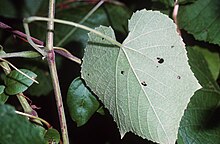Vitis cinerea, the graybark grape, is a variety of grape. It has small black berries that are mildly unpleasant to eat. Plentiful in Missouri and Louisiana, it is also found throughout the eastern half of the US as far west as Texas, north to Illinois, and south to Florida. It is also known by the name winter grape or possum grape. [1][2][3][4][5]
| Vitis cinerea | |
|---|---|

| |
| Scientific classification | |
| Kingdom: | Plantae |
| Clade: | Tracheophytes |
| Clade: | Angiosperms |
| Clade: | Eudicots |
| Clade: | Rosids |
| Order: | Vitales |
| Family: | Vitaceae |
| Genus: | Vitis |
| Species: | V. cinerea
|
| Binomial name | |
| Vitis cinerea | |

| |
Vitis cinerea is an American native grape. The leaves are cordiform-emarinate, flabby, dull, limb finely wrinkled (like crepe) between the sub-veins. The teeth of the leaf are very blunt. The buds are grey-ashy-violet.[6]
References
edit- ^ "Plant Profile for Vitis cinerea". United States Department of Agriculture/Natural Resources Conservation Service. Retrieved 25 August 2017.
- ^ "Illinois Wildflowers Vitis cinerea Description". Illinois Wildflowers Database. Retrieved 25 August 2017.
- ^ "PFAF info for V. cinerea". Plants for a Future Database. Retrieved 25 August 2017.
- ^ "Garden.org V. cineara Information". National Gardening Association Plants Database. Retrieved 25 August 2017.
- ^ "Possum Grape". Carolina Nature: Trees, Shrubs, and Woody Vines of North Carolina. Retrieved 23 August 2017.
- ^ Mazade, Marcel (1900). First Steps in Ampelography: A guide to facilitate the recognition of vines. Melbourne: Robt. S. Brain. p. 34.